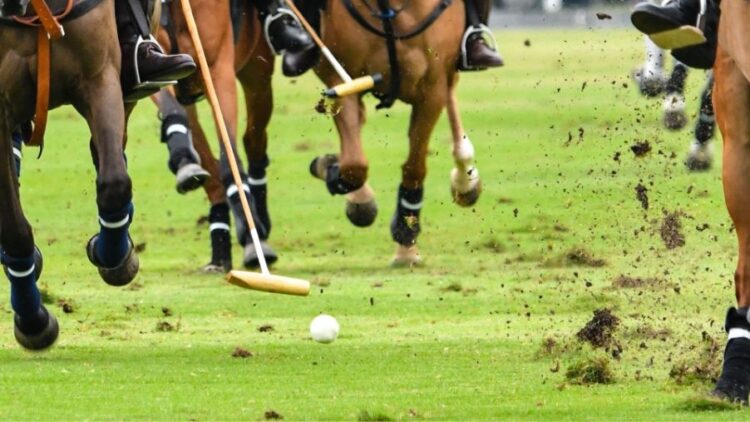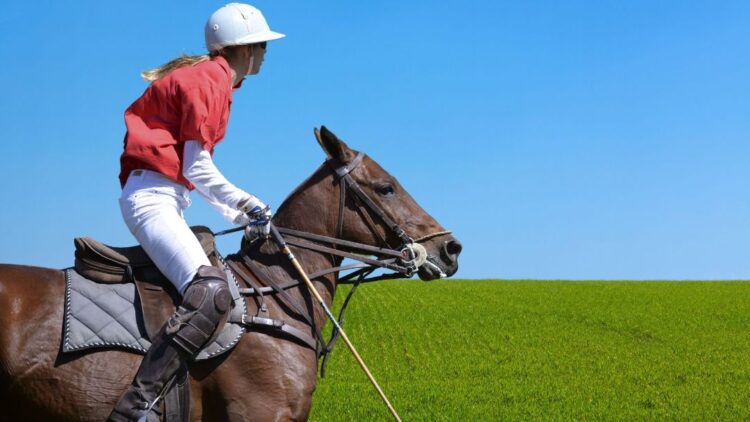
OBJECTIVE OF POLO: Score more points than the opposing team by hitting a ball through the opponent’s goalposts while on horseback.
NUMBER OF PLAYERS: 8 players, 4 per team
MATERIALS: Horse, saddle, polo stick, helmet, knee guards, ball
TYPE OF GAME: Sport
AUDIENCE: 3+
OVERVIEW OF POLO
Every wonder what the famous logo for Ralph Lauren Polo Shirts comes from? Polo is a team-based sport played on horseback. It is very similar to field hockey played by athletes on the backs of horses. The objective of polo is to hit a ball through the opponent’s goalposts using a long mallet.
Polo is a sport that flies under most peoples’ radar, as it is by no means an easily accessible sport. In most cases, any sport that requires a horse is often only played by wealthy individuals who reside in rural areas. In the case of polo, the sport has an even higher barrier to entry, as competitors often need multiple horses to compete.
This stigma of being “the sport of kings” is well-warranted, as polo originally began as a game played in the Middle East by nobility in the 200s BC. However, polo’s popularity slowly expanded far from its Persian origin due to its utility in training cavalry. In the Middle Ages, the sport’s popularity stretched from Constantinople (modern-day Istanbul) to as far east as Japan.
Despite its overwhelming popularity in Asia, polo was relatively unknown to Europe until the British adopted the sport during their colonization of India. The British were taught the sport in Manipur in the mid-1850s. And it is this version of polo, that became the basis of modern international sport.
SETUP
EQUIPMENT
- Horse: The horses used in polo are known as “polo ponies”. The name “pony” can be misleading, as these horses are full-grown thoroughbreds. However, this name comes from the fact that these horses are incredibly agile and fast, similar to a pony.
- Saddle: Polo requires a specialized leather saddle that provides the rider with extra grip when leaning off the horse to hit the ball.
- Polo Stick: Also known as a mallet, this bamboo or fiberglass stick is used to hit the ball. The head of the stick (used to strike the ball) often weighs about half a pound.
- Helmet: Polo helmets are used to protect the riders from falls or another player’s mallet swings. Interestingly, these helmets somewhat resemble a large padded baseball hat.
- Knee Guards: Protection is often worn to protect the knees, shins, and feet from being hit by another player’s mallet.
- Ball: A polo ball is made of high-impact plastic and measures 3 inches in diameter and 4 ounces in weight.
TEAMS AND POSITIONS
A polo team consists of four total players. Each player has their own position with a distinct set of responsibilities:
- Number 1: This position is also known as the attacking offensive player, they are the team’s primary scorer and is responsible for driving the ball up the field. Often a rookie or a team’s most inexperienced player, this position is tasked with defending the opponent’s least offensive player, number 4.
- Number 2: This position is responsible for helping number 1 on offense, either through directly scoring or passing to their teammate. This position also has the challenging task of guarding the opponent’s number 3.
- Number 3: This position is generally reserved for a team’s best player. This player essentially acts as the team’s captain and is responsible for hitting long passes to the offense and being a stalwart on defense.
- Number 4: This position is the team’s primary defender. While they don’t function as a goalie, they are always the last line of defense and allow the number 3 to facilitate the offense without having to worry about conceding a goal defensively.
GAMEPLAY

A polo match is played on a grass field measuring 300 yards in length and 160 yards in width. On this massive field, all eight players essentially crowd around the ball as it is brought up and down the length of the field, players hitting it with their bamboo mallets. Each team attempts to hit the ball through their opponent’s goalposts, which sit roughly eight yards apart. Upon scoring, both teams switch sides.
This action lasts until the end of the “chukker”, or period of play that lasts 7 minutes, and players have an additional 30 seconds to complete any ongoing play. Each match contains between four and six chukkers.
SCORING
One point is scored every time a player hits the ball through the opponent’s goalposts. After scoring, both teams switch which side of the field they’re defending; this is to account for any sunlight or wind advantages/disadvantages either team may have.
CHANGING HORSES
The skill and ability of a rider’s horse account for roughly 75% of a rider’s success. If the horse is unable to respond well to the rider’s rein and leg cues, the rider is basically useless to their team. Part of what makes polo such an expensive sport is that a rider needs multiple horses to compete, as a single horse will get too tired to play an entire match. A player is allowed to change horses between or during chukkers.
Each competitor needs at least two horses to compete; however, this number can increase to well over five at the higher levels of play.
HANDICAPS
In polo, a handicap is essentially a rating system designed to equalize competition among players of differing skill levels. Each country may have a slightly different scale, although most rate players between -2 and 10. A higher handicap score signifies a better player, with a perfect 10 being an incredibly prestigious feat.
Before a match begins, all players on a team have their handicap scores combined to be compared with their opponent’s. The lower handicap score is subtracted from, the higher handicap score, resulting in a starting point differential. In other words, the team with the lower handicap starts with a multi-goal lead equal to the difference between the two teams’ handicap scores.
At the highest levels of play, most players have a very high handicap score.
A RIGHT-HANDED SPORT
One of the most interesting aspects of polo is the fact that players are required to use their right hand to wield the mallet. This is entirely due to safety reasons, as opposite-handed players would often cause collisions with each other.
RULES

Due to the fact polo features close contact between competitors on massive horses, the sport contains many rules designed with safety in mind for both the players and horses:
- The player who last touched the ball has the right of way; all other players cannot impede this player’s path.
- Galloping head-on or across the path of an opponent with the ball in an act of intimidation or to alter their path is not allowed.
- Riding outside the field of play or in a way that could endanger the umpires is also forbidden.
- A rider must not make contact with another player’s horse in a manner that could cause the horse to fall.
Any of these fouls can result in the umpire blowing a whistle to stop play. Then, depending on the severity of the penalty, a free hit can be awarded at the goal from varying distances of 30, 40, or 60 yards.
In the case of severe penalties, an outright penalty goal can be awarded to the affected team. Similarly, free penalty shots with no defenders may also be awarded.
LINE OF THE BALL
The line of the ball is an essential rule in polo that determines the right of way and the direction of play. The rule is designed to avoid collisions between horses and riders for safety reasons.
The line of the ball is an imaginary line on which the ball travels. The player on the line of the ball has the right of way and cannot be interfered with. However, the line of the ball can be stolen by others by pushing the player out of the line in a “ride-off” to steal the ball. Alternatively, other players can use a ” hook ” technique, in which the defensive player uses their mallet to hook onto the line player’s mallet or horse to interfere with a shot.
STRATEGY
Strategy plays a critical role in the game of polo. One common strategy is the use of set plays, which are pre-designed tactics that teams use to gain an advantage. These can include plays mentioned above, such as:
- The line of the ball: Players strategically position themselves along the line of the ball to gain an advantage.
- The ride-off: The player uses their horse to challenge opposition team members and push an opponent off the line of the ball.
- The hook: The player uses their mallet to interfere with an opponent’s shot.
Successful execution of these plays can give a team the edge they need to score a goal.
While set plays are important, polo players must also be adaptable. Teams must be able to adapt their strategy on the go based on the changing conditions of the game. This requires skills like quick thinking and communication.
DIFFERENT TYPES OF POLO
While the rules and basic gameplay of the sport are the same, there are many different types of polo played around the world. One common type is arena polo, which is played on a smaller field with boards around the edges to keep the ball in play. Arena polo is played with three-player teams and consists of four chukkers.
Another variation is snow polo, which is played on a field covered in snow. Snow polo is a popular winter sport in places such as Switzerland and Aspen, Colorado, and requires players to use specially trained horses with special shoes to grip the snow. The gameplay in snow polo is similar to arena polo, but the slower pace of the game and the softer ball make it more accessible to beginner players.
END OF GAME
A polo match ends after the clock counts down to 0 during the final chukker period. The team with the highest score wins the match.
In the event of a tie at the end of regulation, a sudden death chukker period ensues, with the first team to score a goal winning the match.
- 30 GAMES TO PLAY OVER TEXT - April 22, 2024
- 20+ FREE PRINTABLE BABY SHOWER GAMES - April 16, 2024
- 20+ College Party Games for the Best Night Ever! - April 2, 2024